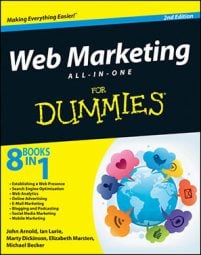Pay per click (PPC) is a popular web marketing tool: You place an ad on a website, pay the site owner for each click-through (that is, every visitor who clicks through to your site), and enjoy the exposure. Like everything else, PPC has its own jargon, which the following list can help you sort through:
ad group: Where and how your ads and keyword lists are organized.
campaign: Where your ad groups are organized; budgets for spending are set; and other settings are made, such as geography, frequency, and networks.
CPC (cost per click): The amount you pay each time your ad is clicked.
CTR (click-through rate): The percentage of how many times your ad was clicked, divided by how many times it was shown.
destination URL: The address of the web page that your ads go to.
display URL: The web address displayed in your PPC ad.
impressions: How many times your ad was shown.
keyword: The words and phrases you select to bid on.
match type: Determines how specifically you want the search engine to match a searcher's query to your keyword list. The types are broad, phrase, exact, negative, and modified broad.
maximum CPC: The dollar amount you set that you are willing to pay for each time your ad is clicked.

